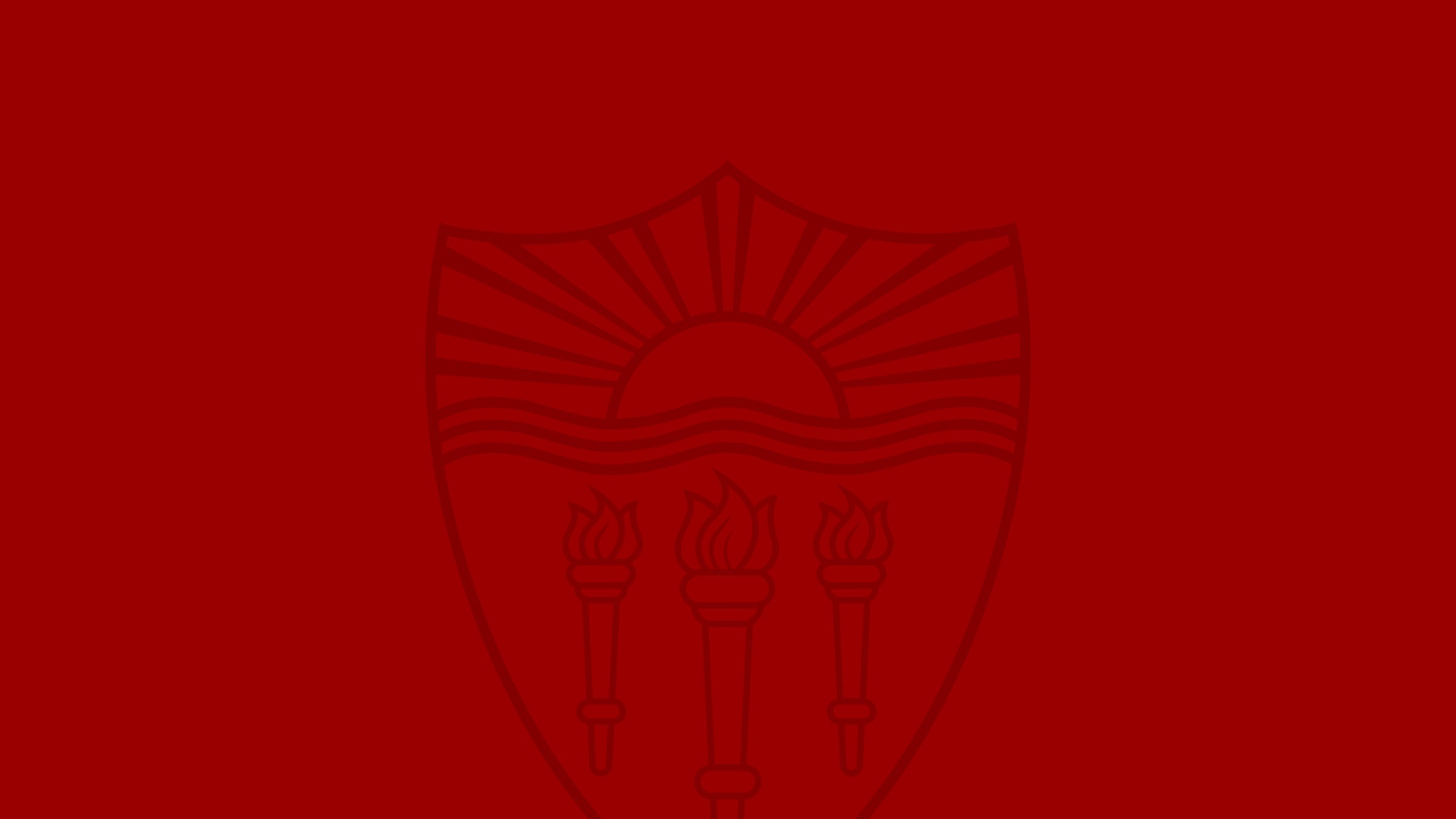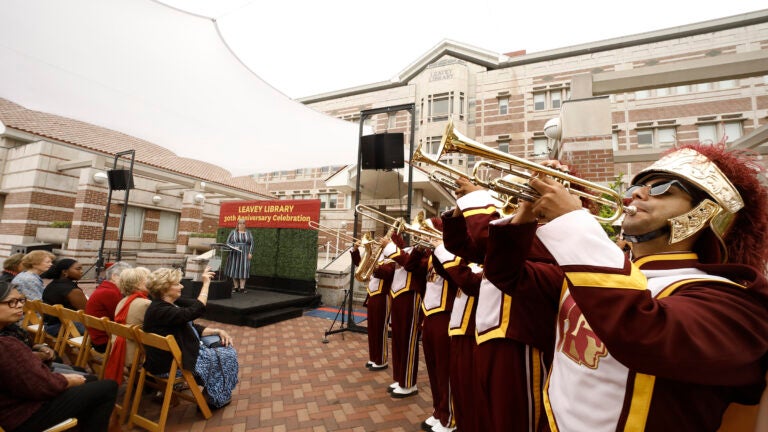
The USC Trojan Marching Band celebrates Leavey Library’s 30th anniversary in style on Wednesday as Melissa Just, dean of USC Libraries, looks on. (USC Photo/Steve Cohn)
5 things you need to know about Leavey Library
The popular study spot, tech hub and home to USC Shoah Foundation celebrated its 30th anniversary on Wednesday.
When the Thomas and Dorothy Leavey Library first opened its doors on the USC University Park Campus on Aug. 29, 1994, the internet was just emerging as a technological force. “Leavey,” as it’s affectionately known by Trojans, was conceived as a new kind of library — one that would serve as a gateway to the digital information age. As the library celebrates its 30th anniversary, we look back on Leavey’s beginnings and trace its evolution through the decades.
-
Wired for a new era
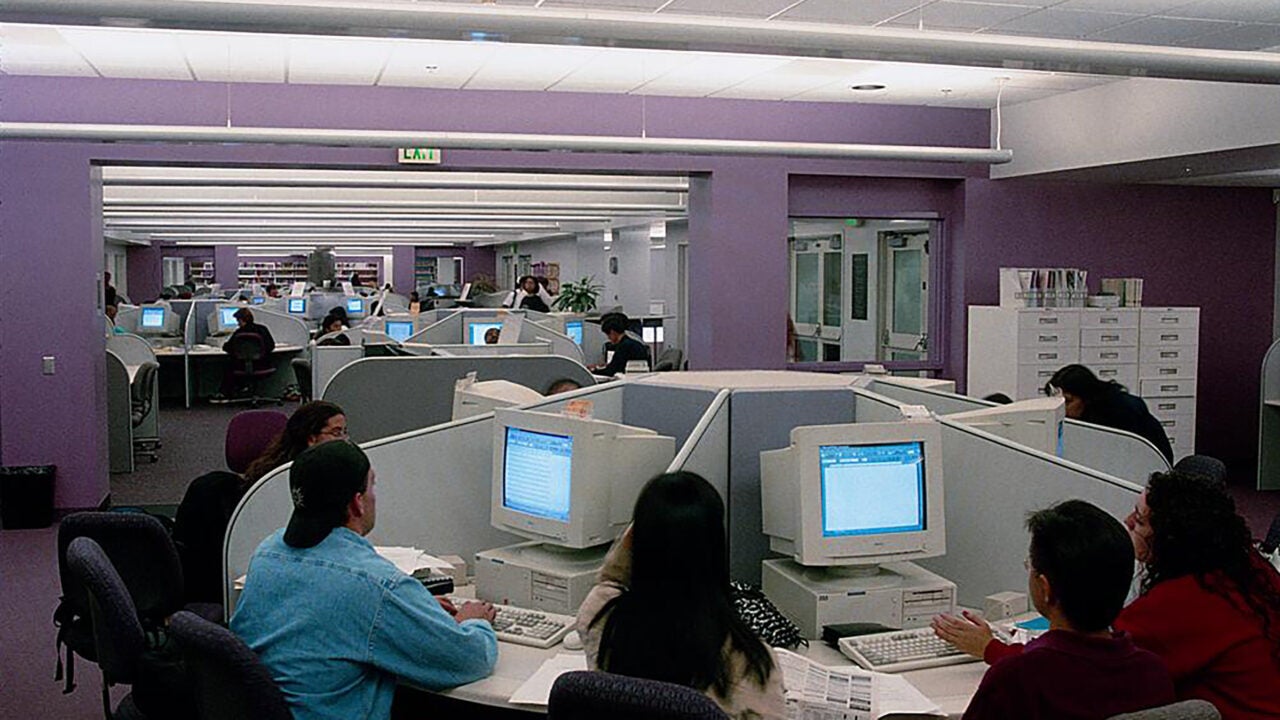
Leavey was built at a moment when the internet was changing the way people searched for and accessed library materials. The library was intended as a resource center for innovative teaching and learning to help Trojans navigate the dawning epoch of digital information.
When it debuted, students and faculty alike came to learn to use early iterations of databases and search engines, such as Gopher. A first-of-its-kind help desk was staffed not just by librarians who could assist with research but also by information technology specialists who could provide tech support. The library’s design allocated more space to computer labs, classrooms and study areas than to bookstacks.
“Leavey really was a model of the library of the future,” says Christal Young, the head of Leavey Library and student engagement.
RELATED: Leavey Library marks its 30th anniversary. Learn more in USC News.
During its first year, over a million people flocked to Leavey. Among them were representatives from libraries near and far who came to observe the new internet-driven library prototype that Leavey represented — one that helped redefine the nature and function of the modern university library.
“The whole world came by to visit the library after it first opened to take back ideas for their own libraries,” says Kathleen Leavey McCarthy, a USC life trustee whose family foundation provided the lead naming gift for Leavey. “Its legacy is more than we ever anticipated.”
-
Tech that’s progressed with the times
Through the decades, Leavey has continued to offer hands-on experiences with advanced tech tools. On the library’s third floor, the Ahmanson Lab — which opened in 2017 as a part of the USC Sidney Harman Academy for Polymathic Study — is a hive of digital scholarship. Students can take introductory skill-building workshops in vector graphics, 3D modeling, 3D printing, user-experience design, simulation development and other creative technologies.
They can also apply these tools to yearlong collaborative projects that bridge interdisciplinary research and digital fabrication. Additionally, the Ahmanson Lab helps faculty integrate digital exhibits and multimedia research projects into their courses using Scalar — an open-source authoring and publishing platform developed by USC researchers and supported by USC Libraries, the USC Dornsife College of Letters, Arts and Sciences and the USC School of Cinematic Arts.
In 2018, USC Shoah Foundation — The Institute for Visual History and Education, founded by filmmaker Steven Spielberg in 1994, opened its new headquarters on Leavey’s fourth floor. The institute houses more than 59,000 audiovisual testimonies given by survivors of genocide conducted in 70 countries and in 45 languages — one of the largest digital collections of its kind in the world. Leavey has collaborated with the institute on various cultural memory and technology projects.
On Leavey’s lower level, USC’s Information Technology Services (ITS) department manages the Ahmanson Information Commons. In this tech support hub, students can check out laptops for personal use and get software help. They can also use collaborative multimedia spaces in ITS’s Digital Creative Lab, which opened in 2023 and includes a gaming PC room, an esports broadcast station, two podcast production rooms, plotters and 3D printers.
Just as the first Leavey librarians helped Trojans navigate a new wave of web-based information, library staff are now helping students and faculty grapple with information culled and created by artificial intelligence. Based in Leavey, the USC Libraries Teaching & Learning Department — led by Michaela Ullmann, head of instruction and assessment at USC Libraries — offers workshops for faculty on using generative AI in the classroom and guidance for students on integrating materials sourced by AI into research papers.
“The library is an active participant in the campus network, helping to understand, address and teach AI literacy,” says Melissa Just, dean of USC Libraries.
-
Keep calm and study on
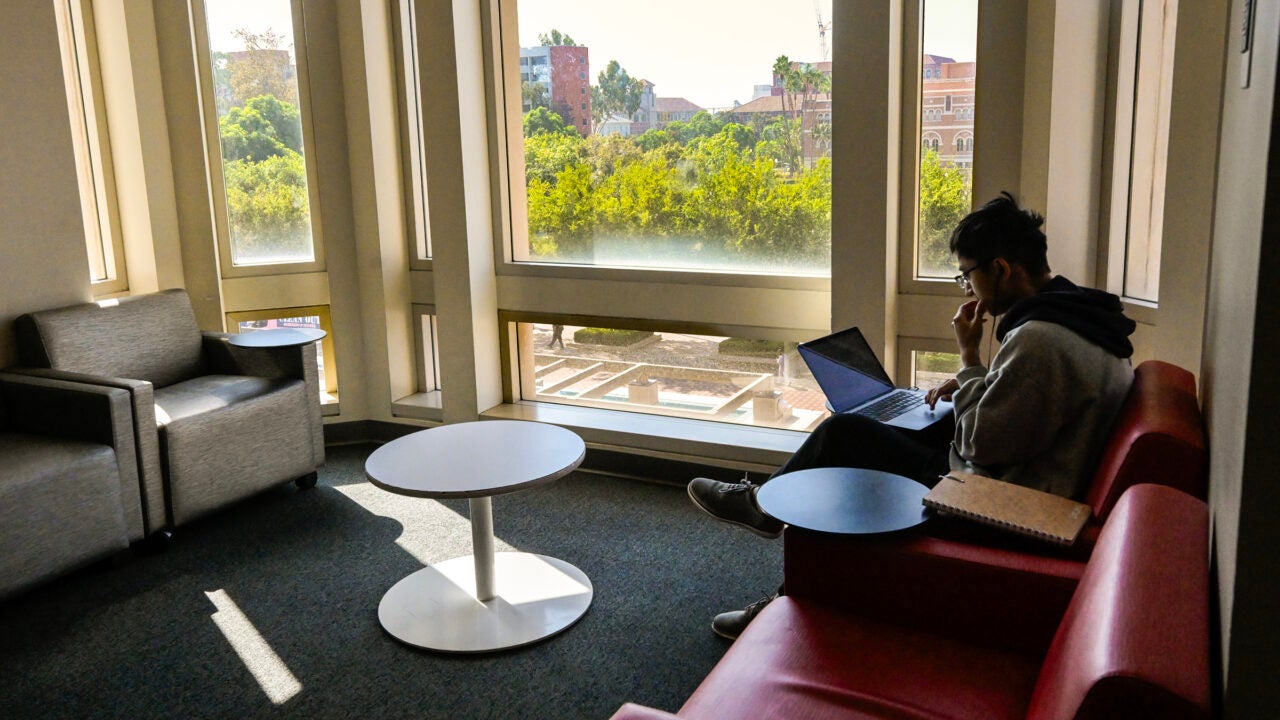
Though technology access and instruction remain part of Leavey’s DNA, the library’s focus has evolved over the years to meet student needs more holistically.
With its variety of individual study spaces and group study rooms, Leavey is the most popular study spot on campus. At critical points during the semester, especially around final exams, the collective stress is palpable. In 2015, library staff introduced the “Study On!” program to support students’ physical and mental wellness. “We wanted students to know that Leavey wasn’t just a place where you came to be stressed out,” says Young.
Library staff members partner with various groups on campus — the USC Kortschak Center for Learning and Creativity and USC Counseling and Mental Health Services, among others — to offer stress-reduction events during finals week and the Study Days that precede it. These events have included chair massages, therapy dogs, coloring activities, and complimentary coffee and cookies. Students can also find stress-relieving study break ideas through the program’s website.
With the support of the USC Libraries Student Academic Emotional Support Program, endowed by Jan List, Young has plans to expand the year-round wellness offerings at Leavey. One project already in the works is creating a designated campus “rest spot” at the library in coordination with the Undergraduate Student Government’s RestSC.
-
“Club Leavey”
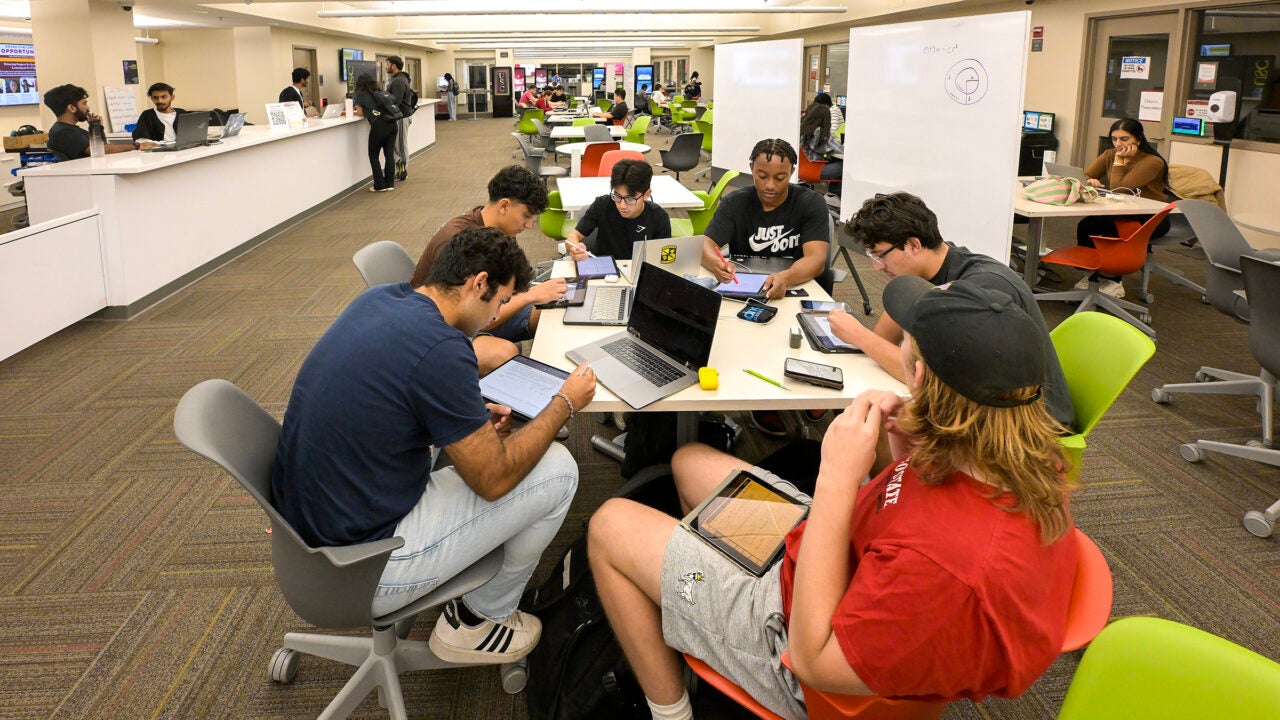
In 1998, in response to student demand, Leavey expanded its hours to stay open around the clock on select days. Now, during the school year, Leavey is generally open 24 hours, five days a week — making it a magnet for students pulling “all-nighters.”
Jada Cobbett, a senior majoring in health promotion and disease prevention at the Keck School of Medicine of USC, is among the scores of Trojans who have burned the midnight oil at Leavey — and found themselves in good company. “You feel the vibe of people wanting to succeed,” says Cobbett, who has been a student administrative worker at Leavey since her first year. “Seeing everyone focused on their assignments really motivates me to keep working.”
While Cobbett prefers Leavey’s quieter study areas, including second- and third-floor spaces and the Weingart Reading Room on the first floor, Leavey’s lower level has a livelier atmosphere. Here, movable furniture allows students to configure group study experiences, and open conversation isn’t frowned upon.
Legend has it that students once held secret dance parties in one of the lower-level group study rooms at 2 a.m. This unsubstantiated legend may well be the origin of the library’s nickname, “Club Leavey.”
In September, Young leaned into the nickname and partnered with Late Night ’SC to host a Friday night silent disco on the Leavey front patio. It’s one among many events, including celebrations for Día de los Muertos and Diwali, that the library hosts to bring students together.
“It’s a great place for building community,” Cobbett says.
-
Don’t forget the books — and films
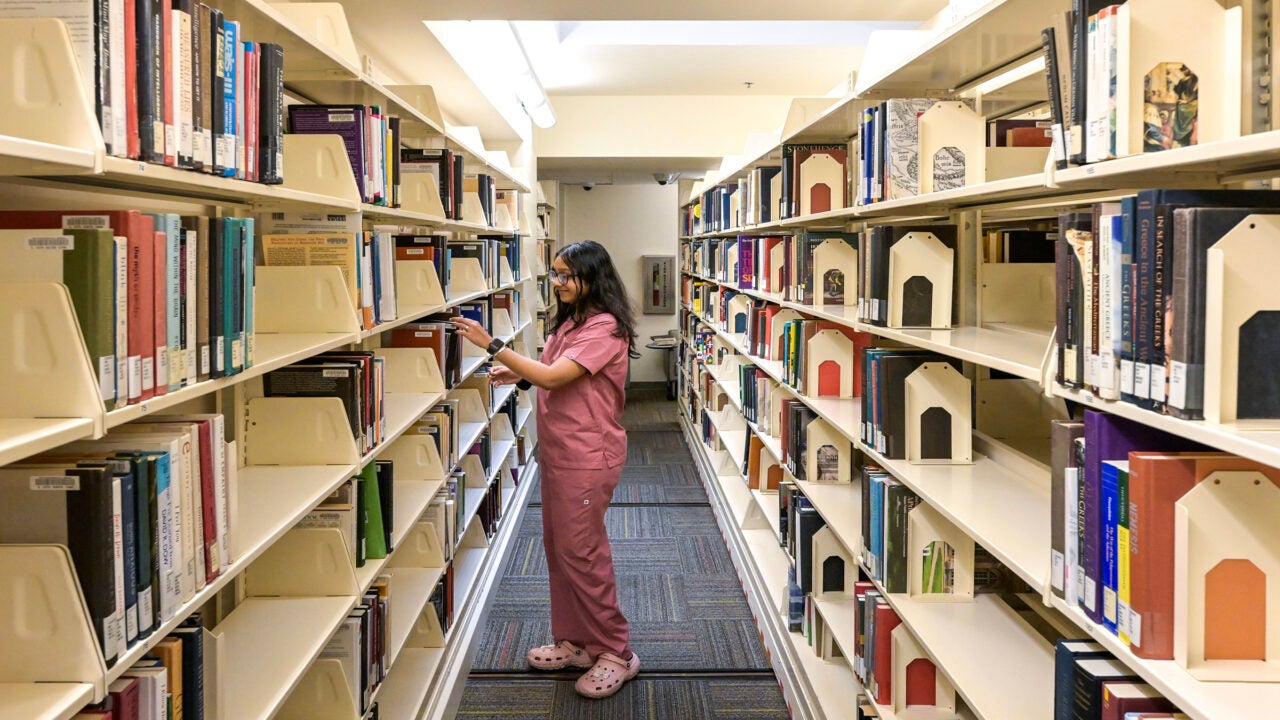
Though Leavey wasn’t built primarily as a repository for books, plenty of worthwhile books can be found on its shelves.
The library’s core interdisciplinary collection — featuring fundamental texts in the arts, humanities and sciences — is housed on the lower level. These books “help students understand foundational themes before they move on to the more in-depth materials found in specialized libraries around campus,” Young says.
In the lobby of the library’s second floor, you’ll find the McNaughton Collection, which features recently published fiction, nonfiction, cookbooks, biographies, graphic novels and more in a wide variety of popular genres. The selection of “leisure reading” is intended to offer students and faculty a break from academic tomes.
“It’s an ever-changing collection,” Young says. “We change the books every few months to get the most current New York Times bestsellers.”
Leavey also has a film library of more than 11,000 DVDs, in addition to its streaming media collection. If you don’t have a DVD player to watch your selection, you can check out an external DVD drive at the library.
These relics from the 1990s stand in stark contrast to the cutting-edge tech resources available at Leavey today. Even as it preserves the past, the library continually looks ahead to the future.

